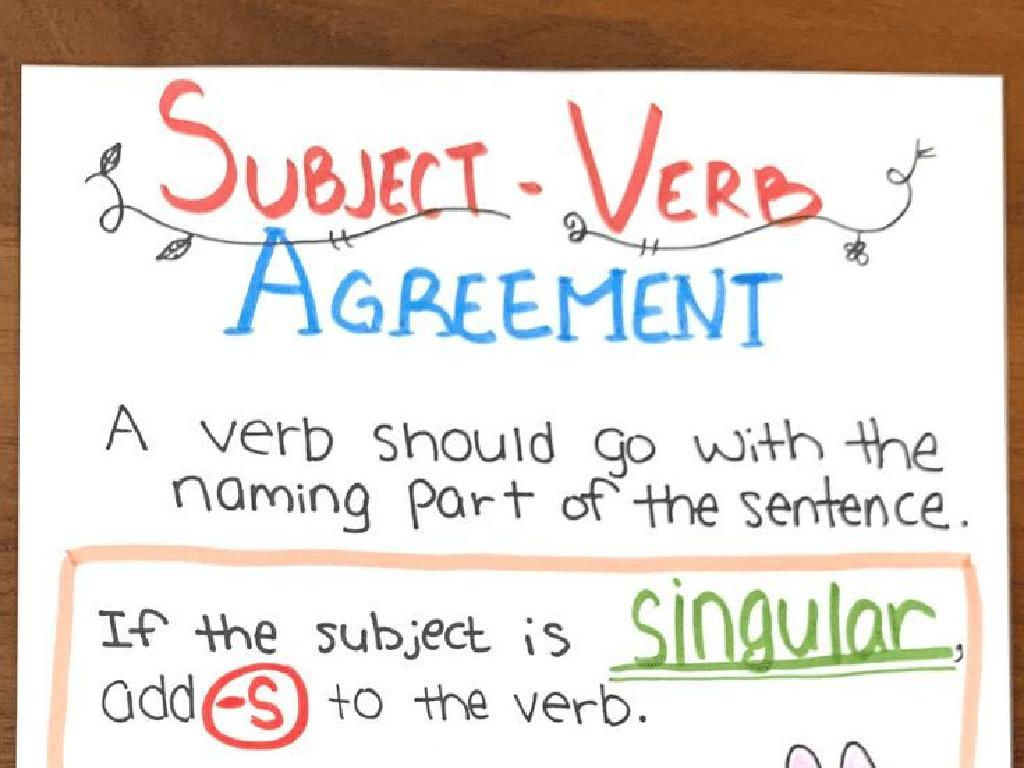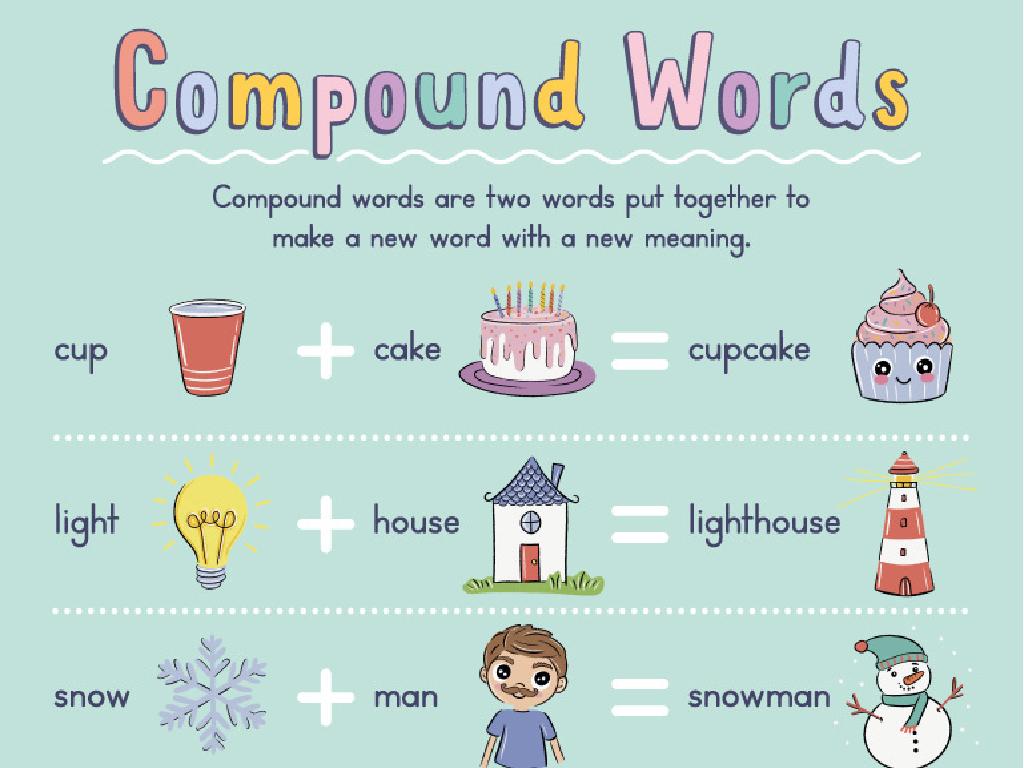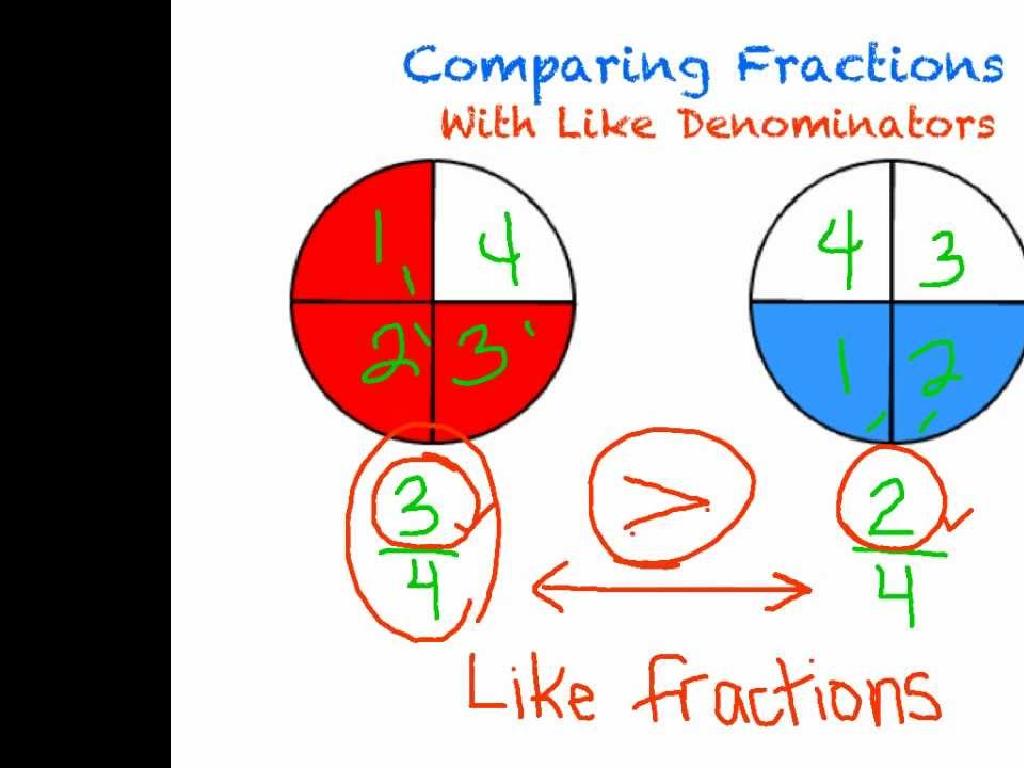Divide Fractions And Mixed Numbers: Word Problems
Subject: Math
Grade: Sixth grade
Topic: Divide Fractions
Please LOG IN to download the presentation. Access is available to registered users only.
View More Content
Welcome to Divide Fractions!
– Quick recap of fractions
– Fractions represent parts of a whole
– Today’s goal: dividing fractions
– Learn to divide fractions by whole numbers and other fractions
– Divide mixed numbers
– Understand how to convert and divide mixed numbers
– Fraction division in real life
– Use fraction division in cooking, budgeting, and more
|
Begin with a brief review of what fractions are and how they represent parts of a whole, ensuring students recall the basics. Today’s objective is to understand how to divide fractions by whole numbers and other fractions, including proper and improper fractions. Additionally, teach students how to handle mixed numbers by converting them to improper fractions before division. Emphasize the practicality of fraction division by discussing its applications in everyday life, such as dividing a recipe into smaller portions or splitting a budget. Provide examples and encourage students to think of other scenarios where they might use fraction division.
Understanding Fraction Division
– What is fraction division?
– Splitting a whole into equal fractional parts
– Dividing objects into equal parts
– Example: A pizza cut into 8 equal slices
– Division as inverse of multiplication
– Understand division as repeated subtraction
– Practice with word problems
|
This slide introduces the concept of fraction division to sixth-grade students. Begin by explaining that fraction division is the process of dividing something into a number of equal parts, which is a fundamental skill in mathematics. Use relatable examples such as dividing a pizza to make the concept more tangible. Clarify that division can be seen as the inverse operation of multiplication, and introduce the idea of division as repeated subtraction. Provide word problems for students to apply their understanding of fraction division in practical scenarios. Encourage students to visualize the process and to use real-life examples to grasp the concept better. The goal is for students to become comfortable with dividing fractions and mixed numbers through practice and application.
Dividing Whole Numbers by Fractions
– Divide whole numbers by fractions
– Example: 4 ÷ 1/2
– How many 1/2s are in 4? Visualize cutting a cake into halves.
– Multiply by the reciprocal
– Instead of dividing, multiply by 2/1 (the reciprocal of 1/2).
– Practice with word problems
– Apply this method to solve real-world problems.
|
This slide introduces the concept of dividing whole numbers by fractions. Start by explaining the process step-by-step, ensuring students understand that dividing by a fraction is the same as multiplying by its reciprocal. Use the example 4 ÷ 1/2 to illustrate the concept visually, such as how many half pieces can be made from a whole item. Emphasize the importance of flipping the fraction to find the reciprocal and then multiplying. Provide additional word problems for students to practice this method, reinforcing their understanding through real-world scenarios. Encourage students to visualize the division as a way to determine how many times a fraction can fit into a whole number.
Dividing Fractions by Fractions
– Learn ‘Flip and Multiply’ rule
– To divide fractions, invert the divisor and multiply
– Example: 1/3 ÷ 2/5
– Flip 2/5 to 5/2, then multiply: 1/3 x 5/2 = 5/6
– Practice: 3/4 ÷ 1/2
– Flip 1/2 to 2/1, then multiply: 3/4 x 2/1 = 3/2 or 1 1/2
– Solve and discuss results
|
This slide introduces the concept of dividing fractions by using the ‘Flip and Multiply’ rule. Start by explaining that to divide by a fraction, you multiply by its reciprocal (flip the second fraction). Use the example 1/3 ÷ 2/5 to illustrate this, showing the steps of flipping 2/5 to become 5/2 and then multiplying it by 1/3 to get the answer 5/6. Then, engage the class with a practice problem, 3/4 ÷ 1/2, and solve it together, ensuring to flip 1/2 to get 2/1 and then multiply by 3/4 to find the result 3/2, which can also be written as 1 1/2. Encourage students to discuss their results and understanding of the process. This interactive approach helps solidify their grasp of dividing fractions.
Dividing Mixed Numbers
– Convert mixed to improper fractions
– Change 2 1/3 to 7/3 and 1 1/4 to 5/4
– Example: Divide 2 1/3 by 1 1/4
– 7/3 ÷ 5/4 = 7/3 x 4/5 = 28/15
– Use ‘Flip and Multiply’ technique
– Flip the divisor and multiply
– Practice with different problems
|
Begin by explaining the process of converting mixed numbers to improper fractions, ensuring students understand the multiplication and addition involved. Use the example 2 1/3 ÷ 1 1/4 to demonstrate the process step by step. Emphasize the ‘Flip and Multiply’ rule, also known as multiplying by the reciprocal, and practice this technique with the class using various mixed numbers. Encourage students to solve problems on their own to solidify their understanding. Provide additional examples for students to work through, and be ready to assist those who need help with the conversion process or the multiplication step.
Dividing Fractions: Word Problems
– Comprehend the word problem
– Read carefully to understand what the problem is asking for.
– Spot the fractions involved
– Identify all the fractions that the problem presents.
– Apply fraction division
– Use the rule ‘invert and multiply’ to divide the fractions.
– Solve and check your answer
– After solving, ensure the solution makes sense in the context of the problem.
|
This slide aims to guide students through the process of solving word problems involving the division of fractions. Start by reading the problem thoroughly to understand what is required. Next, identify the fractions that are involved in the problem. Teach students to apply the division of fractions by inverting the divisor and multiplying. Remind them to simplify their answers when possible. Finally, encourage students to check their answers to ensure they make sense within the context of the problem. For example, if the word problem is about dividing a batch of cookies among a certain number of people, the answer should be a reasonable amount of cookies per person.
Class Activity: Fraction Division Challenge
– Pair up for fraction word problems
– Solve and discuss your methods
– Share solutions with the class
– Relate skills to real-life scenarios
– Discuss practical applications, like dividing a pizza or measuring ingredients for a recipe.
|
This activity is designed to promote collaborative learning and problem-solving skills. Students will work in pairs to tackle word problems involving the division of fractions, encouraging them to communicate and reason together. After solving the problems, each pair will present their solution and explain the method they used to the rest of the class, fostering a deeper understanding through peer teaching. The group discussion on real-life applications of fraction division will help students see the relevance of math in everyday life, such as in cooking or sharing resources. For the teacher: Prepare diverse word problems of varying difficulty to cater to different skill levels. Possible activities could include dividing a set of objects evenly, splitting a recipe into smaller portions, or calculating the time spent on individual activities if a task is shared between people.
Wrapping Up: Division of Fractions
– Review key points from today
– Homework: Fraction division problems
– Solve word problems involving fraction division to reinforce today’s lesson
– Next lesson: Multiplying fractions
– We’ll explore how to multiply fractions in our upcoming class
– Keep practicing and ask questions
– Practice makes perfect! Reach out if you’re stuck on a problem
|
As we conclude today’s lesson on dividing fractions and mixed numbers, it’s important to recap the main concepts to reinforce learning. For homework, students are expected to complete a set of word problems that apply today’s lesson, which will help solidify their understanding of fraction division. Looking ahead, our next class will focus on the multiplication of fractions, building on the knowledge from today. Encourage students to practice regularly and remind them that it’s okay to ask for help if they encounter difficulties with their homework. This will prepare them for the next lesson and ensure they are comfortable with the material covered so far.






